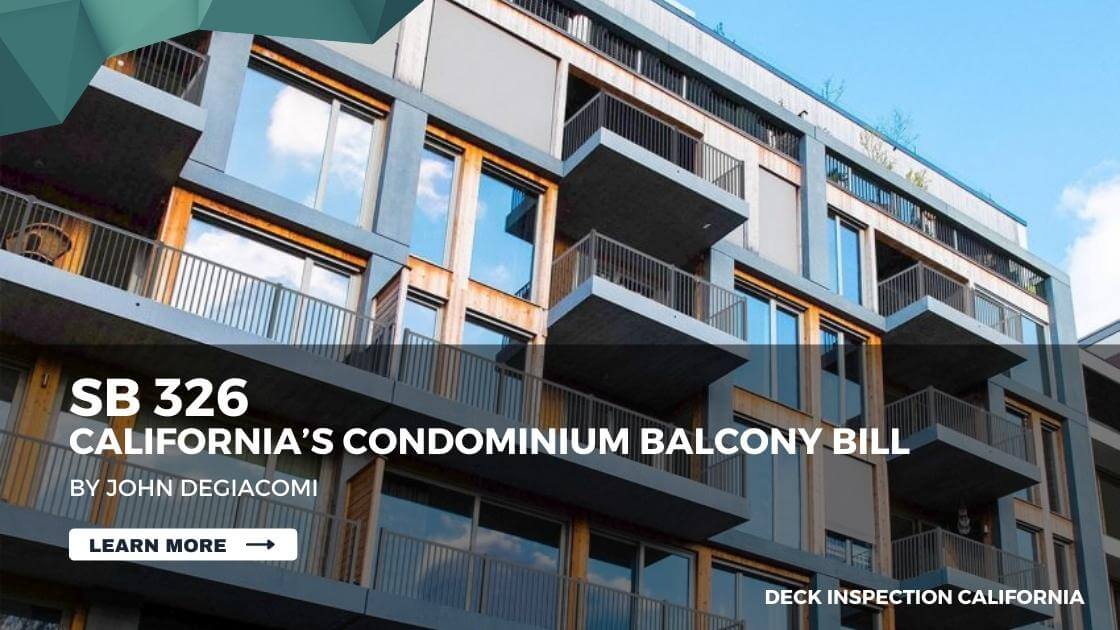Updated on October 18, 2023 by John DeGiacomi

Senate Bill 326 is California's definitive step towards ensuring residential safety. This legislation mandates regular inspections of certain exterior elevated elements, such as balconies, terraces, and walkways with wooden components, to address potential safety concerns.
As part of the Home Owners' Association, understanding and adhering to this law is paramount, both for personal safety and for protecting your investment. However, navigating the specifics can be daunting.
With expertise in SB326 requirements, we at Deck Inspection California have put together a quick guide you can use as a reference. This will help you find the right path and better understand the complexities of the Balcony Inspection Bill. Scroll on to learn more.
Senate Bill 326, commonly referred to as SB326, is a pivotal piece of California legislation. This bill focuses on the safety and integrity of exterior elevated elements (EEE) in multi-family residences.
Note that wood structures above six feet from the ground are considered EEE.
This bill was initiated in response to tragic incidents involving a balcony collapse that ended in the death of six college students in Berkley, California.
The bill emphasizes the necessity of periodic visual inspection. These inspection cycles target elements primarily supported by wood or wood-based products, such as balconies, decks, and terraces.
Visual inspection aims to identify and rectify potential structural flaws. By enforcing these inspections, the law ensures that potential hazards are addressed proactively, fostering a safer living environment.
If you're HOA, understanding SB326 isn't just about compliance; it's about ensuring that one's residence or investment possesses structural stability and is hazard-free.
Undertaking an SB 326 inspection, especially for Homeowners Associations (HOA), requires a methodical approach.
Given the gravity of safety concerns and the specificity of requirements, understanding each step is essential.
Here's a strategy for efficient balcony inspections:
Identify the Elements: Ensure that all wooden elevated exterior elements are earmarked for inspection. This includes balconies, decks, and even certain terraces.
Choose Qualified Professionals: Only a licensed structural engineer, architect, or certified building inspector should be hired for the job. Their expertise is pivotal to a comprehensive and accurate inspection. If they advise that the exterior elevated element poses an immediate threat to the safety of the occupants, this information should be heeded.
Documentation is Key: Post-inspection, a detailed report outlining the findings must be generated. This not only acts as a compliance document but also serves as a record for future inspections.
Updated Checks: The initial inspection should be completed by January 1, 2025, with subsequent inspections at least every nine years.
Act on Findings: Any identified issues or potential hazards should be addressed promptly to ensure the continued safety of residents.
Non-compliance with SB326 is not an option that homeowners or HOAs should consider.
Failing to adhere to the inspection requirements set out by this legislation carries both tangible and intangible consequences:
Legal Repercussions: Associations will face fines or even lawsuits for neglecting to comply. These legal actions can result in significant financial burdens and damage to reputation.
Safety Concerns: Without timely inspections, potential structural issues might go unnoticed. This negligence can endanger residents and visitors alike. The risk of a catastrophic incident, such as a balcony collapse, becomes a looming threat.
Financial Implications: Properties that aren't compliant may see a decrease in their market value. Non-compliance can also result in costly building department fees.
Mandatory Interventions: In extreme cases, non-compliant properties are reported to the local code enforcement agency within 15 days. The association shall take preventive measures immediately, including barring occupancy until criteria are met.
For peace of mind and the well-being of all residents, compliance with SB 326 is a responsibility that cannot be taken lightly.
Selecting the right professional to complete an SB326 inspection report is crucial.
The law stipulates specific qualifications to safeguard the safety of residents and the longevity of the property. When seeking an inspection expert, consider the following skills and qualifications:
Licensing and Certification: The professional should be a licensed architect, structural engineer, or certified building inspector. This ensures they have the foundational knowledge to conduct thorough evaluations.
Specialized Training: Given the unique challenges of inspecting EEE, specific training in this area is vital.
Experience: Seek professionals with a proven track record of performing inspections related to SB 326, as experience often leads to a more refined assessment.
Attention to Detail: A meticulous approach is paramount, as minor oversights can lead to significant consequences.
Knowledge of Waterproofing Systems: Understanding and evaluating associated waterproofing systems, integral to any EEE, is a must.
Legislation Know-how: The professional should be abreast of all nuances and updates related to SB 326 to ensure full compliance.
Hiring right is the first step in ensuring safety and compliance. Deck Inspection California stands out as a trusted partner in this area.
Balcony inspection is meticulous and designed to ensure the utmost safety. The inspector who comes in must visually inspect a statistically significant sample of the building's EEEs. The size of the building determines the exact number of EEEs to be inspected.
If you're unfamiliar with the procedure, here’s a breakdown of what to expect during this crucial evaluation:
Preliminary Assessment: Before diving into the detailed inspection, professionals will typically conduct an initial walkthrough to familiarize themselves with the layout and structure of the exterior elevated element.
Detailed Evaluation: The core of the inspection involves a thorough check of all EEE. The inspector focuses on potential structural flaws and vulnerabilities, especially in wood and wood-based components.
Waterproofing Assessment: Given the significance of waterproofing in prolonging the life of balconies and decks, a dedicated examination of these systems is conducted.
Documentation: Photographs, notes, and other evidence are collected during the inspection process to create a comprehensive report detailing all findings.
Discussion of Findings: Post-inspection, the professionals will discuss their findings with the homeowners or HOA representatives, highlighting areas of concern and offering recommendations for remediation.
Detailed Report: A formal report is a necessary component of a diligent visual inspection. It outlines all observations, findings, and recommendations. This document is essential for compliance purposes and future reference for the next balcony inspection.
Understanding these steps clarifies the inspection process and helps homeowners and HOAs better prepare for it. With clear expectations set, the entire procedure becomes smoother and more efficient.
The primary goal of an SB 326 inspection is to ensure safety. If an inspection reveals areas of concern, repairs might indeed be necessary.
Here are some common circumstances or elements that could require remediation:
Wood Rot or Decay: One of the most prevalent issues in wooden exterior elevated elements. Moisture exposure over time can lead to wood rot, compromising the structural integrity of decks and balconies.
Faulty Waterproofing: If waterproofing is found to be inadequate or deteriorating, it needs to be corrected immediately to prevent further damage.
Visible Cracks: Cracks, especially in load-bearing sections, indicate structural stress and require attention.
Loose Fixtures: Railings, support beams, or any other fixtures that appear loose or wobbly pose a safety hazard.
Corrosion: Metal fixtures or supports showing signs of rust or corrosion can weaken over time and may need replacement or treatment.
Previous Subpar Repairs: Sometimes, previous repair attempts that don't meet the required standards can be a cause for concern.
Homeowners and HOAs should prioritize these repairs not just for SB 326 compliance but for the overall safety and longevity of the property. Always consult with professionals like Deck Inspection California to understand the full scope of necessary repairs.
Absolutely! Contact us here. When it comes to SB 326 inspections, the importance of working with skilled and knowledgeable professionals cannot be stressed enough. Deck Inspection California stands out as a leader in the industry.
Our years of experience inspecting a multitude of decks and balconies across diverse properties have made us experts in this area. Our team ensures that inspections are conducted with precision and adherence to state requirements.
Deck Inspection California is a full-service business that offers guidance on any needed repairs, ensuring your property remains safe and maintains its value.
Ensure your association's exterior elevated elements are safe and strong with Deck Inspection California -- your partner in ensuring safety, compliance, and peace of mind.

© 2023, Deck and Balcony Inspections - SB 326 and SB 721 Inspections - Servicing all of California. - CSLB #1052109